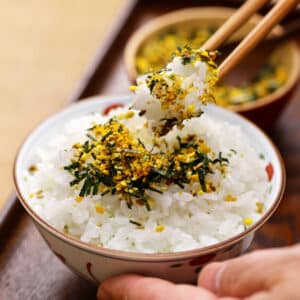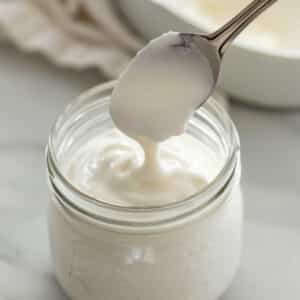Craving a sprinkle of umami magic on your everyday meals? Let's dive into how to make Furikake, a cherished Japanese rice seasoning that'll add flavor to any dish. With toasted sesame seeds, crumbled nori seaweed, and pan-fried bonito flakes, this recipe is as versatile as it is tasty.
Making Furikake involves toasting sesame seeds, crumbling nori seaweed, and lightly frying bonito flakes. These ingredients are mixed together with a bit of sugar and salt. It's a simple process that results in a flavorful seasoning used widely in Japanese cuisine.
Take aways:
- Toast to Taste: Toasting the sesame seeds until golden adds an extra layer of nuttiness to the Furikake. Also, toasting the Nori amplifies its oceanic umami notes.
- Personalize Your Furikake: As you get more comfortable making Furikake, start customizing it.
- Store Properly: Storing your Furikake correctly is critical. Keep it in an airtight container in a cool, dry place.
Jump to:
A brief overview of Furikake
Furikake, oh how I adore this seasoning! It's a game-changer, a culinary chameleon, that brings a blast of umami to any dish. Opening a jar of Furikake is like unveiling a rainbow of colors and textures - dried ground fish, sesame seeds, chopped seaweed, a touch of sugar and salt, and yes, MSG.
This Japanese dry seasoning was initially intended for enhancing rice, veggies, and fish, but let's broaden our horizons. Why not sprinkle some magic on an air-fried dish? My recommendation - try the Furikake Salmon Air Fryer recipe. The flavors blend beautifully, completely transforming your usual salmon dish into a vibrant gastronomic adventure!

The importance and use of Furikake in Japanese cuisine
Furikake is not just a seasoning; it's an integral part of Japanese culinary culture. In fact, you could say it's the secret weapon of Japanese cuisine. Think of it as the parmesan cheese of Japan—something to sprinkle on top of a dish right before you eat it to add a final burst of flavor.
Furikake has been used in Japan for over a century and is on every dinner table. It's often used to enhance the flavor of a bowl of plain rice—imagine a confetti of taste that turns a simple bowl of rice into a feast! But it doesn't stop there. We've seen Furikake make its way into Western kitchens, adding an unexpected twist to popcorn, salads, and even baked potatoes.
In the culinary masterpiece "Japanese Cooking: A Simple Art" by Shizuo Tsuji, Furikake is described as a "workhorse of Japanese cuisine." It has the unique ability to amplify flavors and add a delightful crunch that can elevate a dish from good to unforgettable. And it's not just about flavor.
Related Read: Top 11 Mistakes to Avoid When Making Furikake Salmon
Basic Furikake base ingredients
Furikake is a marvel of simplicity, built on a few essential ingredients. Here's what you'll typically find in my kitchen when I'm about to whip up a batch:
- Roasted Sesame Seeds: They add a nutty flavor and a delightful crunch. You'll want both black and white seeds for contrast.
- Dried Seaweed (Nori): It offers an unmistakable brine depth. I usually chop it into thin, small flakes.
- Dried Bonito Flakes: These lend a smoky, umami-rich flavor. Bonito is a type of fish, dried and flaked into thin wisps.
- Sugar: Just a touch balances out the savory notes.
- Salt: This brings out all the other flavors. I recommend good-quality sea salt.
- MSG (optional): Some folks shy away from it, but a small amount of MSG can provide an extra umami boost.
Optional Additions
Remember, the beauty of making Furikake lies in the scope for customization. Here are a few additional ingredients I've played around with over the years:
- Dried Shrimp or Fish: These can add a different dimension to the flavor profile. Ensure they're finely chopped or ground.
- Wasabi Peas: These give a spicy kick to your Furikake. You'd want to crush them before adding.
- Shiso Leaves: If you can find dried shiso leaves, they'll add a unique and refreshing flavor.
- Chili Flakes: For those who love a bit of heat, chili flakes can be a great addition.
- Dried Egg Yolk: This is more common in store-bought Furikake, but you can try it at home. You'll need to bake and then grate the yolks.
- Furikake with no Fish: You can make a vegetarian version of Furikake by leaving out the bonito flakes and using ingredients like dried vegetables and mushrooms.
Feel free to experiment with these optional additions. After all, the best recipes are those that you tweak to your taste!
Read: Furikake Salmon Recipe
Step-by-step process of making Furikake
Ah, the joy of making your own Furikake! Here's how we can create our very own customized Furikake seasoning at home:
Step 1 Gather the ingredients
For a basic Furikake, we'll need roasted sesame seeds, dried seaweed (like Nori), dried bonito flakes, sugar, and salt. Don't worry if you don't have everything. Remember, we've talked about substitutions and additions that can customize your Furikake to your liking.
Step 2 Preparing the ingredients
Now comes the fun part! We need to prepare each ingredient carefully:
- Roasting the Sesame Seeds: If your sesame seeds aren't already roasted, we need to fix that. Toast them gently in a dry pan over medium heat until golden brown and aromatic.
- Crushing the Seaweed: Nori usually comes in sheets, but we want it in flakes for our Furikake. You can crumble it by hand or put it in a blender to get the right consistency.
- Preparing the Bonito Flakes: Bonito flakes are usually ready to use straight out of the package, but if you want a finer texture, you can blitz them in a blender or grind them in a spice grinder.
Step 3 Mixing it all
The key is to balance the savory, sweet, and salty flavors. Mix the sesame seeds, seaweed, and bonito flakes in a bowl. Then, add sugar and salt to taste. I recommend starting with a ratio of 5:1:1 (sesame seeds: sugar: salt) but feel free to adjust it to your liking.
Step 4 Final touches
Give your mixture a good stir until everything is well combined. Taste your Furikake and adjust the flavors if needed. Maybe you want it a little sweeter or saltier? This is your creation, after all!
Step 5 Storing Your Furikake
Transfer your homemade Furikake to an airtight container. It can be stored at room temperature and should last for several months. But honestly, it's so delicious that it probably won't stick around that long!
Just like that, you've created your very own Furikake seasoning!
The next time you serve up a bowl of steamed rice, sprinkle some of this magic on top and see the dish come to life. As chef Harumi Kurihara writes in her book "Harumi's Japanese Cooking," food should be a "feast for the eyes as well as the mouth," a sprinkle of your homemade Furikake will add that special touch.
Furikake: Ingredients breakdown
When I started making Furikake, I was taken aback by how a handful of simple ingredients could create such a profound flavor. Let's dissect these ingredients and understand the role each one plays in this magical seasoning.
- Roasted Sesame Seeds: These tiny powerhouses are more than just a garnish. They bring a nutty, toasted flavor to the vital mix. And that crunch! It's like music to your palate. In "The Japanese Grill" by Tadashi Ono and Harris Salat, sesame seeds are described as the "unsung heroes of Japanese cuisine" - I couldn't agree more.
- Dried Seaweed (Nori): I've learned that subtle flavors make a dish stand out. Nori is the undercurrent of the sea in Furikake. It's not shouty or dominant, but without it, you'd miss that whisper of the ocean.
- Dried Bonito Flakes: This is where the umami punches come from. Bonito flakes are, in essence, flavor bombs. They're smoky, they're fishy, and they bring a depth that anchors the Furikake.
- Sugar: A touch of sweetness rounds off Furikake's flavor profile. It's like the conductor in an orchestra, ensuring all the other tastes play together harmoniously.
- Salt: Without salt, Furikake would be like a song without rhythm. It's the most basic ingredient, yet it has the critical job of enhancing all the other flavors.
- MSG (optional): Ah, the misunderstood MSG. Some love it, and some avoid it. But in Furikake, it works as an umami amplifier, tasting up a notch.
Read: Cheesecake Factory Miso Salmon Copycat Recipe
Insights into the selection of quality ingredients
When it comes to cooking, I firmly believe in the adage, "You are what you eat." That's why selecting quality ingredients is so crucial.
For your Furikake, look for organic sesame seeds if possible - they're often fresher and more flavorful. For Nori, try to source it from a reliable supplier to ensure it's impurities-free. Bonito flakes are best when they're thick-cut, indicating higher quality. And pure sea salt can make all the difference in salt.
Remember, the better the ingredients, the better your Furikake will be. So, don't compromise on quality. As they say in "Washoku: Recipes from the Japanese Home Kitchen" by Elizabeth Andoh, "Quality is never an accident; it is always the result of intelligent effort."
Exploring variations: Ingredient substitutions and additions
One of the reasons I find joy in making Furikake and even a Furikake substitute is the flexibility it offers. The traditional recipe is just a starting point; you can let your culinary creativity soar. Let's look at some ingredient substitutions and additions I've experimented with in the journey of creating that perfect Furikake substitute.
- Roasted Sesame Seeds: If you don't have sesame seeds or are allergic, try using hemp or flax seeds. They bring their unique nuttiness to the mix.
- Dried Seaweed (Nori): A better substitute would be another thin, dried seaweed such as dulse or wakame. These are much closer to Nori in terms of texture, and they can be easily crumbled or ground into small pieces to blend well with the other Furikake ingredients. Kombu is a good substitute. It's another type of seaweed with a stronger flavor but still delivers that oceanic hint. Learn more here.
- Dried Bonito Flakes: Shiitake mushroom powder can be a fantastic substitute for vegetarians or those who don't eat fish. It's earthy and full of umami, mimicking the role of bonito flakes.
- Sugar and Salt: Considering your sugar and salt intake, consider substitutes like Stevia and low-sodium salt alternatives. They'll help keep the balance of flavors while fitting your dietary needs.
Unconventional Additions
The world of Furikake is not limited to traditional ingredients. Here are some out-of-the-box additions:
- Freeze-Dried Fruits: Tiny bits of freeze-dried fruits like pineapple or mango can add an unexpected sweet-tart element to your Furikake.
- Spices: A little bit of ground Szechuan pepper or a hint of five-spice powder can give your Furikake a unique twist.
- Nuts: Chopped pistachios or almonds can add a new dimension of texture and flavor.
The Effect of Variations
Adding spices can take your Furikake from traditionally Japanese to a global fusion. When you play around with the ingredients, you're essentially crafting a whole new flavor profile. For instance, using shiitake mushrooms instead of bonito makes your Furikake earthier.
Remember, the goal here is to create a seasoning that you love. As chef Masaharu Morimoto said in his book "Mastering the Art of Japanese Home Cooking," "Cooking is about making ordinary ingredients into extraordinary dishes." So, feel free to let your imagination run wild and make your Furikake extraordinary.
Pro tips and tricks for perfect Furikake
Furikake is such a simple yet versatile seasoning. Here are some expert advice and solutions to common problems you might encounter:
Tip 1 Toast sesame seeds properly
Toasting sesame seeds can be a bit tricky. You want them to be golden and aromatic but not burnt. My trick? Keep the heat medium-low, and don't leave them unattended. As soon as they change color, stir them, and once they're uniformly golden, get them out of the pan.
Tip 2 Balance the flavors.
Finding the right balance between the salty, sweet, and umami flavors is key. Always taste your Furikake as you mix it, and don't be afraid to adjust the quantities to your liking. Remember, adding more than taking away is easier, so add salt and sugar sparingly at first.
Tip 3 Make it your own
The best thing about making Furikake at home is that you can customize it. Love sesame seeds? Add more. Not a fan of bonito flakes? Skip them. Or maybe you want to get creative and add some chili flakes for a spicy kick, as suggested by chef Nobu Matsuhisa in his book "Nobu: A Memoir." Your Furikake, your rules.
Problem: My Furikake is clumping
This usually happens if your ingredients aren't completely dry. Use dry, roasted sesame seeds and properly dried seaweed and bonito flakes. If you're adding other ingredients, ensure they're also dry.
Problem: My Furikake is too salty/sweet
No worries! If you find your Furikake too salty or sweet, you can balance it by adding more other ingredients. Adding more sesame seeds or bonito flakes can help balance excess salt, while a little more seaweed can temper too much sweetness.
How to store and use Furikake
Storing and using Furikake properly can make all the difference. It can keep your seasoning fresh for longer, and knowing the versatility of this wonderful sprinkle will open up a world of culinary possibilities. Let's delve in!
Storing Furikake
After you've taken the time to make your own Furikake, you want to ensure it stays as fresh and flavorful as possible. Here's my golden rule for storing Furikake:
Keep it in an airtight container in a cool, dark place. Light and heat can cause the Furikake to lose its flavor faster, and exposure to air can make it soggy. Your pantry or kitchen cabinet away from the stove or oven is ideal. Also, remember always to use clean, dry utensils to scoop out your Furikake.
Using Furikake
Furikake is traditionally sprinkled on top of rice, but its uses go way beyond that. Trust me, after a decade of experimenting with this seasoning, I've found it can add a flavor punch to many dishes. Here are a few of my favorite ways to use Furikake:
- On Eggs: Scrambled, fried, or boiled eggs, and Furikake is a match made in heaven. The seasoning adds a savory crunch that complements the eggs' soft, mild flavor.
- In Soups: A sprinkle of Furikake on top of a bowl of soup can add a whole new dimension of flavor. It works particularly well with creamy soups, like the Kabocha Soup recipe in "Japanese Soul Cooking" by Tadashi Ono and Harris Salat.
- With Seafood: Furikake and seafood are a classic pairing. Try it sprinkled on grilled fish or mixed into a tuna salad. You won't be disappointed.
- On Popcorn: Yes, you read that right! Next time you're having a movie night, swap the salt for some Furikake on your popcorn. It's a game-changer.
- In Salad Dressings: Mix some Furikake into a simple vinaigrette for an umami-packed salad dressing. It's a quick way to elevate any salad.
Exciting ways to use your homemade Furikake
Now that you've got your homemade Furikake, it's time to explore its potential. This humble Japanese seasoning has a knack for elevating various dishes, turning the ordinary into extraordinary. Here are some of my favorite and slightly adventurous ways to use Furikake. Let's get your creative cooking juices flowing!
1 Make your avocado toast pop.
Furikake and avocado are a flavor match made in culinary heaven. The creamy, rich avocado plays well with the savory crunch of Furikake. Just mash a ripe avocado on toasted bread, sprinkle with Furikake, and voilà! You've got a breakfast fit for a king.
2 Supercharge your pasta
Sure, parmesan is great, but have you tried Furikake on pasta (like Miso Carbonara)? The umami goodness of the Furikake pairs perfectly with a simple garlic and oil pasta. Or, try it with a creamy Alfredo sauce. The seasoning adds a delightful complexity to the dish.
3 Level up your baked potatoes.
Next time you make baked potatoes, try sprinkling some Furikake on top. It's like a flavor explosion in your mouth. If you're a fan of "The Japanese Grill" by Tadashi Ono and Harris Salat, you might remember their recipe for grilled potatoes. Try adding Furikake to those for a twist!
3 Mix it into your hamburger patties.
This is one of my secret tricks. Mixing Furikake into your hamburger patties before you cook them can give your burgers an unexpected umami punch. It's a surefire way to impress at your next barbecue.
4 Use it as a pizza topping.
Yes, you heard me right. Furikake on pizza. It adds a salty, savory crunch that perfectly complements the gooey cheese and tangy tomato sauce. Try it on a Margherita pizza or a white pizza.
5 Add a twist to your popcorn.
I've mentioned this before, but it bears repeating. Furikake on popcorn is a revelation. It's the perfect snack for a night in front of the TV or when craving something salty and savory.
Get creative! Use it in your everyday dishes or try something new. I guarantee you'll be surprised by the depth and complexity it can bring to your cooking. With Furikake, the sky's the limit.
Four inventive ways to use your homemade Furikake seasoning
Oh, Furikake! This delightful seasoning is like the secret magic dust in my kitchen, turning bland dishes into bursts of flavor. If you've made it this far and are already experimenting with your homemade Furikake, I bet you're eager for new and inventive ways to use it.
1 The Rice reviver:
You've probably tried sprinkling Furikake on a bowl of white rice, but have you tried it with other grains? Quinoa, farro, or even barley, can all be livened up with a dash of Furikake. And why stop at rice balls? Mix Furikake into the stuffing of your sushi rolls, or sprinkle it on top of your poke bowl. The contrast in textures will be a delight to your palate.
2 Secret soup ingredients:
Next time you're simmering a miso soup or even a hearty stew, try adding a tablespoon of Furikake. The depth it adds is simply out of this world. This is a tip I picked up from "Japanese Cooking: A Simple Art" by Shizuo Tsuji, and it's been a game-changer.
3 Unconventional garnish:
Now, let's think outside the box. Have you ever tried sprinkling Furikake on your grilled cheese sandwich? Or what about on a slice of pizza? And if you're a fan of avocado toast (who isn't?), adding Furikake will bring it to a whole new level.
4 Snack enhancers:
Furikake isn't just for meals. It can elevate your snack game too. Popcorn, roasted nuts, or even potato chips can benefit from a dusting of Furikake. The book "Japanese Soul Cooking" by Tadashi Ono and Harris Salat suggests using Furikake on homemade potato chips, and I have to say, it's an absolute winner.
Remember, these suggestions are just the tip of the iceberg. The beauty of Furikake lies in its versatility. So, don't be afraid to get creative and sprinkle it on anything that could use a punch of umami.
Full Recipe
How to Make Furikake Seasoning
Pin RecipeIngredients:
- 1 tablespoon Roasted Sesame Seeds
- 1 tablespoon Dried Seaweed (Nori)
- 1 tablespoon Dried Bonito Flakes
- 1 teaspoon Sugar
- ½ teaspoon Salt
- ½ teaspoon MSG (optional)
- *Always taste your Furikake as you mix it, and don't be afraid to adjust the quantities to your liking.
Instructions:
Gather the Ingredients:
- For a basic Furikake, we'll need roasted sesame seeds, dried seaweed (like Nori), dried bonito flakes, sugar, and salt. Don't worry if you don't have everything. Remember, we've talked about substitutions and additions that can customize your Furikake to your liking.
Prepare the ingredients:
- Roasting the Sesame Seeds: If your sesame seeds aren't already roasted, we need to fix that. Toast them gently in a dry pan over medium heat until golden brown and aromatic.
- Crushing the Seaweed: Nori usually comes in sheets, but we want it in flakes for our Furikake. You can crumble it by hand or put it in a blender to get the right consistency.
- Preparing the Bonito Flakes: Bonito flakes are usually ready to use straight out of the package, but if you want a finer texture, you can blitz them in a blender or grind them in a spice grinder.
Mixing it all:
- The key is to balance the savory, sweet, and salty flavors. Mix the sesame seeds, seaweed, and bonito flakes in a bowl. Then, add sugar and salt to taste. I recommend starting with a ratio of 5:1:1 (sesame seeds: sugar: salt) but feel free to adjust it to your liking.
Final touches:
- Give your mixture a good stir until everything is well combined. Taste your Furikake and adjust the flavors if needed. Maybe you want it a little sweeter or saltier? This is your creation, after all!
Storing your furikake:
- Transfer your homemade Furikake to an airtight container. It can be stored at room temperature and should last for several months. But honestly, it's so delicious that it probably won't stick around that long!Just like that, you've created your very own Furikake seasoning!
Notes:
Ingredient substitutions and additions:
- Roasted Sesame Seeds: If you don't have sesame seeds or are allergic, try using hemp or flax seeds. They bring their unique nuttiness to the mix.
- Dried Seaweed (Nori): A better substitute would be another thin, dried seaweed such as dulse or wakame. These are much closer to Nori in terms of texture, and they can be easily crumbled or ground into small pieces to blend well with the other Furikake ingredients. Kombu is a good substitute. It's another type of seaweed with a stronger flavor but still delivers that oceanic hint.
- Dried Bonito Flakes: Shiitake mushroom powder can be a fantastic substitute for vegetarians or those who don't eat fish. It's earthy and full of umami, mimicking the role of bonito flakes.
- Sugar and Salt: Considering your sugar and salt intake, consider substitutes like Stevia and low-sodium salt alternatives. They'll help keep the balance of flavors while fitting your dietary needs.
Storing furikake
After you've taken the time to make your own Furikake, you want to ensure it stays as fresh and flavorful as possible. Here's my golden rule for storing Furikake: Keep it in an airtight container in a cool, dark place. Light and heat can cause the Furikake to lose its flavor faster, and exposure to air can make it soggy. Your pantry or kitchen cabinet away from the stove or oven is ideal. Also, remember always to use clean, dry utensils to scoop out your Furikake.How to use furikake
Furikake is traditionally sprinkled on top of rice, but its uses go way beyond that. Trust me, after a decade of experimenting with this seasoning, I've found it can add a flavor punch to many dishes. Here are a few of my favorite ways to use Furikake:- On Eggs: Scrambled, fried, or boiled eggs, and Furikake is a match made in heaven. The seasoning adds a savory crunch that complements the eggs' soft, mild flavor.
- In Soups: A sprinkle of Furikake on top of a bowl of soup can add a whole new dimension of flavor. It works particularly well with creamy soups, like the Kabocha Soup recipe in "Japanese Soul Cooking" by Tadashi Ono and Harris Salat.
- With Seafood: Furikake and seafood are a classic pairing. Try it sprinkled on grilled fish or mixed into a tuna salad. You won't be disappointed.
- On Popcorn: Yes, you read that right! Next time you're having a movie night, swap the salt for some Furikake on your popcorn. It's a game-changer.
- In Salad Dressings: Mix some Furikake into a simple vinaigrette for an umami-packed salad dressing. It's a quick way to elevate any salad.
Please note that all nutrition information are just estimates. Values will vary among brands, so we encourage you to calculate these on your own for most accurate results.
Frequently Asked Questions
Furikake is a dry Japanese seasoning typically made up of a mix of dried fish (usually bonito flakes), sesame seeds, chopped seaweed, sugar, and salt. Sometimes, you'll find versions that include other ingredients like dried egg or vegetables. The delightful blend of these components gives Furikake its unique flavor profile.
If stored correctly, your homemade Furikake can last up to a month. Keep it in an airtight container at room temperature, away from direct sunlight. If you've used fresh ingredients, make sure they're completely dry before adding them to your mix to avoid any potential for mold growth.
Absolutely! While seaweed lends a characteristic umami flavor and crunch to Furikake, you can create a version without it. You can increase the amount of sesame seeds or bonito flakes or add other dried ingredients you enjoy. Cooking is about personal preference, and Furikake is no exception.
If bonito flakes are out of reach, you can substitute them with other dried fish flakes like salmon or mackerel. For a vegetarian version, consider using dried shiitake mushrooms. They have a rich, umami flavor that somewhat mimics the taste of bonito.
Some Furikake might be gluten-free, but others are not. It all depends on the ingredients used. For instance, soy sauce, a common ingredient in some Furikake, usually contains wheat. However, there are gluten-free soy sauces available. If you're making it at home, you can control the ingredients to ensure it's gluten-free. Always remember to check the labels if you're buying it.
Absolutely! Furikake is incredibly versatile. While it's traditionally used as a rice seasoning, it's equally great on other dishes. It adds an umami punch that enhances just about any dish. Sprinkle it on your avocado toast, popcorn, pasta, baked potatoes, or even pizza.
Furikake is packed with nutrients, thanks to its wholesome ingredients. Seaweed is rich in iodine and vitamins, while sesame seeds are a great source of healthy fats and antioxidants. Bonito flakes provide a dose of protein. Remember, though; it also contains salt and sugar, so just like any seasoning, moderation is key.





